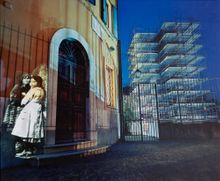ARTIST MONOGRAPHS
|
|
STATUS: Out of print | 00/00/00 For assistance locating a copy, please see our list of recommended out of print specialists |
 Shimon Attie: The History of Another
Shimon Attie: The History of Another
Published by Twin Palms Publishers.
"For a number of years, Shimon Attie (born 1957) has created his own photographic palimpsests, projecting historical images onto public spaces and then photographing them, trying to bring out buried layers of memory. 'I am trying to give visual form to history and memory which is latent in the architecture and landscape of the present, latent but not visible ... More than my therapeutic training, I think my temperament made me interested in revealing layers of a buried or repressed past.' The projected image, Attie says, is a physical embodiment of the process of memory itself. 'Like memory, the projection appears to have substance and materiality, but in fact it does not—it is only photons,' he says. 'It’s an illusion.' The projections of historical photographs onto actual sites in the present have a ghostly, immaterial, ephemeral quality of fleeting memory." — Alexander Stille
PUBLISHER
Twin Palms Publishers
BOOK FORMAT
Hardcover, 17 x 14 in. / 48 pgs / 19 color.
PUBLISHING STATUS
Pub Date 4/1/2004
Active
DISTRIBUTION
D.A.P. Exclusive
Catalog: Publisher Backlist
PRODUCT DETAILS
ISBN 9781931885317 TRADE
List Price: $85.00 CAD $123.00 GBP £75.00
AVAILABILITY
In stock
in stock $85.00 Free Shipping UPS GROUND IN THE CONTINENTAL U.S. |

